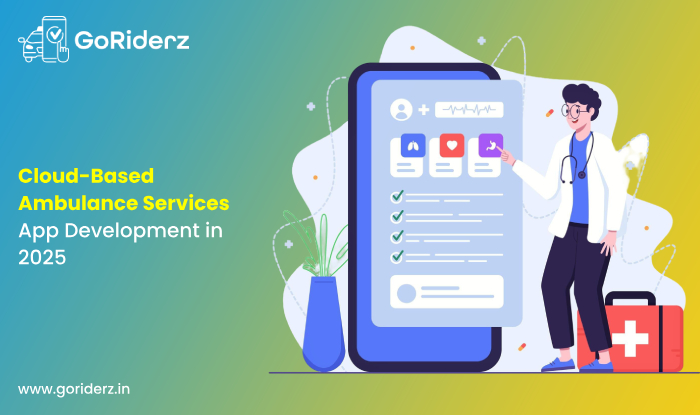
Cloud-Based Ambulance Services App Development in 2025
Table of Contents
What if a few taps on your phone could get help to someone in need right away?
Cloud-based ambulance services apps make this possible by using cloud technology to connect people, dispatchers, and vehicles for faster response. These apps handle emergency ambulance booking with online storage, real-time location updates, and direct links to hospitals.
Ambulance booking services app development focuses on building systems that work across devices without heavy local setup.
Why Build Cloud-Based Ambulance Services Apps Now?
In 2025, more people expect quick access to medical help through their phones. Think about how ride-sharing changed travel; similar ideas now apply to emergencies.
Developers create these apps to cut wait times and improve coordination between teams.
What Is a Cloud-Based Ambulance Services App?
This type of app runs on cloud platforms like AWS or Google Cloud. It lets users request help, tracks vehicles, and shares patient details with medical staff. Because it runs on the cloud, data stays safe and accessible from anywhere, without the need for big servers on site.
Unlike older systems tied to one location, cloud setups adjust easily to demand. During busy times, the app can handle more requests without slowing down.
How Does Cloud-Based Ambulance Services App Work?
Users open the app, enter details such as location and symptoms, and send a request. The cloud system finds the nearest ambulance and alerts the driver. Dispatchers see updates in real time on their dashboard.
Integration with GPS keeps everyone informed, and once the ambulance arrives, data syncs with hospital systems for a smooth handover.
What Are The Key Features to Include in Cloud-Based Ambulance Services App?
If you want your app to stand out, focus on features people need most:
- Real-time tracking – Shows ambulance location on a map.
- Easy booking – Simple forms for quick details.
- Notifications – Alerts about status changes.
- Payment options – Handles fees after service.
- Admin tools – Manage fleets and reports.
Adding voice commands can also help users in stressful situations.
What Are The Cloud-Based Ambulance Services App Trends in 2025?
The key trends in 2025 related to cloud-based ambulance services app are:
- AI predicts busy areas and positions ambulances in advance.
- IoT devices in vehicles send patient vitals to doctors before arrival.
- Telehealth links enable video calls with medics during transit.
- Data privacy rules get stricter, pushing stronger security.
- Cloud setups move to multi-provider models for better uptime.
What Are The Statistics That Matter?
Reports show how fast this field is growing:
- Global ambulance services market size: USD 51.37 billion in 2025 (Precedence Research, 2025).
- Ambulance services market: USD 60.40 billion in 2025 (Mordor Intelligence).
- Global mHealth apps market: USD 86.37 billion by 2030 (Grand View Research).
- USA ambulance services revenue: $22.0 billion in 2025 (IBISWorld).
- Emergency medical apps market: USD 2.3 billion by 2032, up from USD 820 million in 2023 (Dataintelo).
These numbers confirm rising demand for emergency tech.
What Are The Steps to Develop Your App?
These are the steps you would need to follow in order to develop a cloud-based ambulance services app:
- Research needs – Talk to medics and users about challenges.
- Plan design – Sketch user flows and app screens.
- Choose tech – Select cloud providers and frameworks like React for front end.
- Build core – Code booking and tracking features first.
- Test thoroughly – Check speed and reliability in real scenarios.
- Launch and update – Go live, then improve with feedback.
Starting with a small team helps speed things up.
What Are The Challenges in Development?
- Data privacy – Use encryption to protect sensitive details.
- Integration with hospital systems – Start with APIs for smoother links.
- Cloud costs – Pick pay-as-you-go models to control expenses.
- Remote areas – Add offline modes that sync later.
What Are The Benefits for Everyone?
The benefits of having a cloud-based ambulance service app are:
- Patients get faster access to care.
- Providers manage fleets with less downtime.
- Hospitals prepare ahead with patient details.
Together, these apps build stronger emergency response systems. Think of a city where ambulances arrive minutes sooner, that’s the goal.
Conclusion
Building a cloud-based ambulance services app in 2025 means creating tools that save both time and lives. From quick bookings to smarter features, the aim is to make emergency help easier to reach.
As demand grows, now is the right time to act. Connect with us today to start your emergency ambulance booking app development or ambulance booking services app development project.
Let’s make emergencies less stressful together.
FAQs
- What does it cost to build an ambulance app?
Costs range from $50,000 to $200,000 depending on features and team size.
- Which tech stack fits best for these apps?
Use Flutter for cross-platform development, with Firebase for backend.
- How long does development take?
Usually 3–6 months, depending on scope.
- What regulations apply in the USA?
Follow HIPAA for data handling.
- Why choose cloud over on-premise?
Cloud gives flexibility and lower upfront costs.